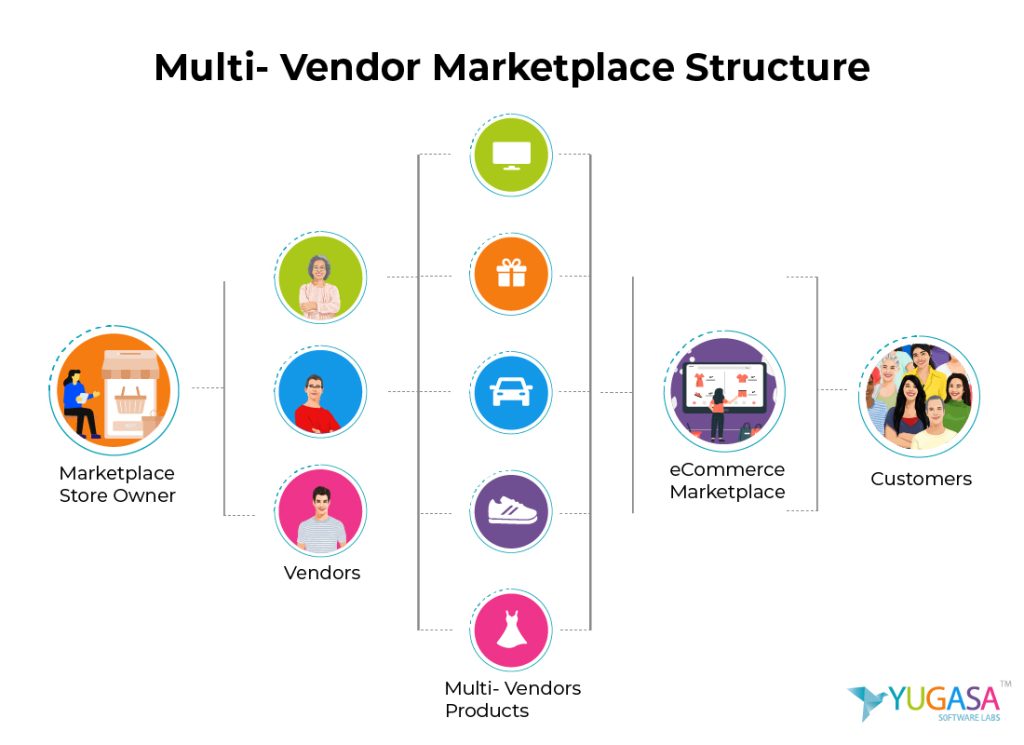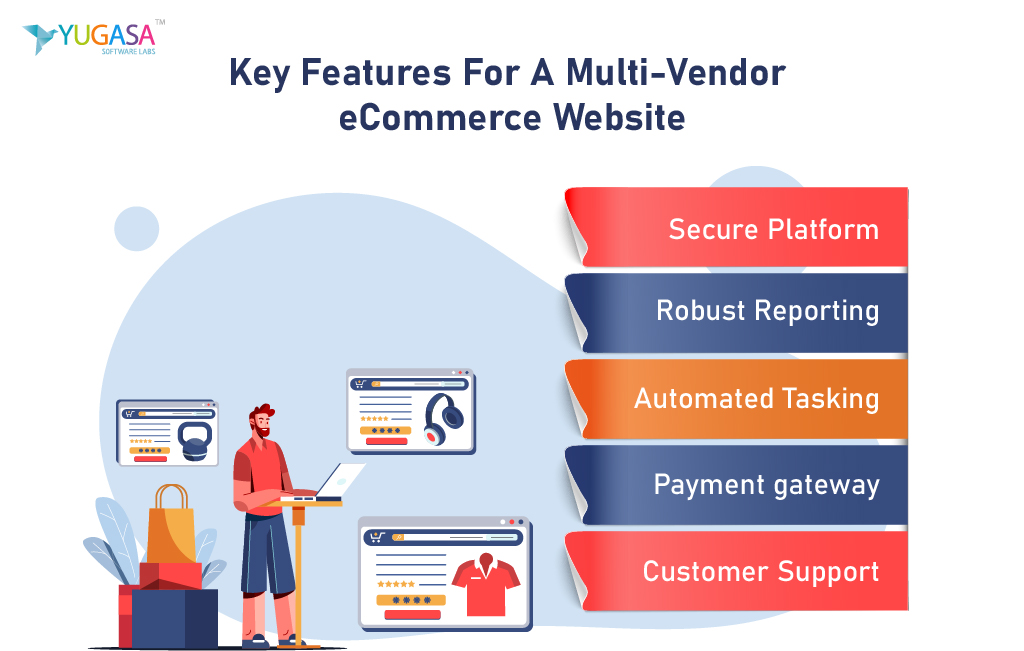Multi-vendor platforms have acquired a lot of popularity in the constantly changing eCommerce space by providing a marketplace where numerous sellers can display their goods and services.
It is imperative that these platforms include critical features that improve security, reporting capabilities, automation, payment processing, and customer support in order to guarantee their success and scalability.
In this blog post, we’ll delve into these essential features and explore their significance in building a robust and user-friendly multi-vendor eCommerce website.

1. Secure Platform:
In an e-commerce enterprise, security is of utmost importance, particularly when dealing with several vendors and handling confidential information and transactions. To include important security features, such as:
● SSL encryption:
The Secure Socket Layer (SSL) protocol guarantees the privacy and security of all data transferred between users’ browsers and websites.
● secure gateways for payments:
Make use of trustworthy payment gateways, including PCI DSS (Payment Card Industry Data Security Standard), that adhere to industry standards for safe online transactions.
● Two-factor authentication:
To prevent unwanted access to user accounts and sensitive data, utilize extra authentication levels like two-factor authentication.
● Frequent security audits:
To find and proactively address possible security threats, conduct regular security audits and vulnerability assessments.
2. Robust Reporting:
Robust reporting features are necessary to track the multi-vendor platform’s performance, examine sales patterns, and make informed decisions.
Consider the following important reporting features:
● Sales reports:
Monitor revenue trends, product popularity, and sales success for various suppliers and categories.
● Inventory management:
Keep an eye on stock levels, track product availability, and get notifications when products run low or are out of stock.
● Metrics for measuring vendor performance:
Assess each vendor’s performance according to sales figures, client feedback, and fulfillment effectiveness.
● Analyse consumer behavior, preferences, and demographics to better target marketing campaigns and enhance user experience.
3. Automated Tasking:
Processes are streamlined, productivity is increased, and administrators’ and vendors’ manual labor is decreased through automation.
Important automation functions that the platform should incorporate are:
● Order fulfillment automation:
To guarantee prompt delivery and raise customer satisfaction, automate order processing, shipment alerts, and tracking updates.
● Inventory synchronization:
To avoid overselling or disparities in stock, automatically synchronize inventory levels among several sellers.
● Commission management:
Based on sales performance and predetermined commission rates, automate commission computations, invoicing, and vendor payouts.
● Customer communication:
To ensure prompt and individualized communication, set up automated email notifications for order confirmations, shipment updates, and customer questions.

4. Payment Gateway:
Enabling seamless and safe transactions between customers and sellers requires a dependable and secure payment gateway.
Important things to think about while choosing a payment gateway are as follows:
● Compatibility:
Verify that the payment gateway works with the multi-vendor platform and accepts a variety of payment options, such as bank transfers, digital wallets, and credit/debit cards.
● Security:
Opt for a payment gateway that adheres to industry standards for fraud protection and data encryption.
● Smooth integration:
Pick a payment gateway that works well with the eCommerce platform to give consumers a simple checkout procedure and to process payments for vendors quickly.
● Scalability:
Select a payment gateway that can grow along with the multi-vendor platform, allowing it to handle higher transaction volumes and a wider range of payment choices.
5. Customer Support:
Responsive and efficient customer support is essential for resolving issues, addressing inquiries, and fostering positive relationships with buyers and sellers.
Key customer support features to include are:
● Multiple channels of customer care: Provide email, live chat, phone support, and self-service assistance tools, among other channels.
● Ticketing system: Set up a ticketing system to prioritize essential issues, keep track of consumer requests, and guarantee prompt resolution.
● Create a thorough knowledge base or FAQ section with answers to frequently asked issues, troubleshooting manuals, and educational films to empower users and lessen their dependence on customer service.
● Support for vendors: Provide specialized channels and materials for vendors to succeed on the platform, such as training manuals, onboarding aids, and troubleshooting tips.
6. User-Friendly Interface:
Improving the overall experience of customers and sellers on a multi-vendor eCommerce website requires a user-friendly interface.
For a user-friendly interface, the following features should be prioritized:
● Easy navigation: Create a user-friendly navigation structure that makes it simple for visitors to browse products, look for particular things, and move between the website’s many parts.
● Responsive design: To guarantee a smooth user experience on all platforms, make sure the website is adjusted for different screen sizes and devices, such as PCs, tablets, and smartphones.
● Product listings that are easy to navigate: To assist customers in making well-informed selections, display product listings that are easy to navigate. This includes providing high-quality photos, thorough descriptions, pricing details, and availability status.
● Streamlined checkout procedure: To lower cart abandonment rates and increase conversion rates, streamline the checkout procedure with a minimum amount of steps, clear instructions, and simple payment alternatives.
7. Social Integration:
Social media platforms and networking channels are leveraged by social integration to increase the multi-vendor eCommerce website’s reach and engagement. Among the essential components of social integration are:
● Social media buttons: Include social media buttons on product pages so that customers can quickly share their top picks with their friends and family. This will boost exposure and improve website traffic.
● Social login: To expedite the registration process and improve user comfort, allow users to access the website using their pre-existing social media accounts, like Facebook or Google.
● Element of social proof: To increase confidence in the products and vendors, place social proof elements like ratings, reviews, and testimonials in a prominent location on product pages.
● Social media integration: To keep customers interested, informed, and connected with the most recent information, deals, and happenings pertaining to the multi-vendor platform, incorporate social network feeds, postings, and updates straight into the website.
FAQs
What role does customer support play in a multi-vendor eCommerce platform?
Taking care of questions, fixing problems, and building strong bonds with customers and suppliers all depend on customer service.
Timely and efficient customer service improves consumer happiness, fosters trust, and helps businesses succeed in the long run.
How does a user-friendly interface enhance the user experience on a multi-vendor eCommerce website?
Finding products, completing transactions, and interacting with the website are all made simpler for users with an intuitive design that enhances readability, navigation, and usability.
Increased engagement, lower bounce rates, and higher conversion rates are all benefits of a well-designed interface.
How can social integration benefit a multi-vendor eCommerce platform?
Social integration makes use of social media platforms to increase the platform’s visibility, reach, and engagement.
By allowing users to integrate social media feeds, showcase social proof components, share items, and log in using their social media accounts, it promotes community engagement and company advocacy.
Final thoughts
In conclusion, the foundation for a successful and long-lasting multi-vendor eCommerce website is laid by combining four essential features: a secure platform, comprehensive reporting, automated tasking, a dependable payment gateway, and attentive customer care.
Businesses may develop a vibrant marketplace that benefits both consumers and sellers and drives growth and profitability in the competitive eCommerce industry by prioritizing security, efficiency, automation, and user pleasure.
























